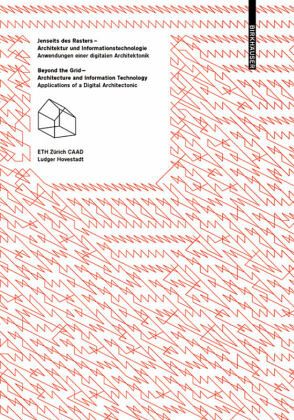Nicht lieferbar

Jenseits des Rasters - Architektur und Informationstechnologie\Beyond the Grid - Architecture and Information Technology
Anwendungen einer digitalen Architektonik. Applications of a Digital Architectonic. Dtsch.-Engl.
Übers.: Tim Danaher
Versandkostenfrei!
Nicht lieferbar
Professor Ludger Hovestadt’s Institute for Computer-Aided Architectural Design at the Eidgenössische Technische Hochschule (ETH) Zürich (Swiss Federal Institute of Technology, Zurich) is widely regarded as one of the world’s most important institutes currently working at the interface between architecture and information technology. The combination of these two makes it possible to see architecture no longer as a separate sphere of technological reality but rather as one element of a society based on information technology. As a universal tool, the computer encourages one to think in terms of information structures and systems that span individual fields. This "rethinking" of the nature of architecture is leading to a paradigm shift at the methodological level of design, planning, construction, and economy. After a decade of experimentation, it has now become possible to see information technology for architecture as the basis for a new and energy-saving practical approach to building. This publication presents the work of the chair for CAAD using numerous examples – from the spectacular Monte Rosa Alpine hut of Andrea Deplazes to the residential development of KCAP.
Professor Ludger Hovestadts Institut für Computer Aided Architectural Design an der ETH Zürich gilt als eines der weltweit wichtigsten Institute auf der Schnittstelle zwischen Architektur und Informationstechnologie. Diese Verbindung ermöglicht es, Architektur nicht mehr als einen getrennten Bereich der technischen Realität zu sehen, sondern als Bestandteil einer informationstechnologischen Gesellschaft. Der Computer als universales Werkzeug propagiert disziplinübergreifend ein Denken in Informationsstrukturen und -systemen. Dieses "neue Denken" von Architektur führt zu einem Paradigmenwechsel auf der methodischen Ebene von Entwurf und Planung, von Konstruktion und Ökonomie. Nach einem Jahrzehnt des Experimentierens ist es nun möglich, Informationstechnologie für die Architektur als Grundlage einer neuen, energiesparenden Baupraxis zu begreifen. Die Publikation stellt die entsprechende Arbeit des Lehrstuhls für CAAD anhand zahlreicher Beispiele vor - von der spektakulären Alphütte Monte Rosa von Andrea Deplazes bis zum Wohnbauprojekt von KCAP.



